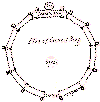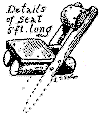by Ernest Thompson Seton
No camp can be truly a Woodcraft Camp without a Council Ring. The Council Ring in the woods about the fire was to original grouping of mankind. When so arranged, we get at once the ancient spirit of the woods--the democratic equalization of responsibility and of honor.
I do not feel that any camp can get the best results without a Council Ring, no matter what organization it may belong to.
I have made 74 of these personally, and that means partly at least with my own hands, and have been responsible for the building of many more.
These are the essentials :-- a dry, level, beautiful place in the woods, not more than a quarter of a mile from headquarters, and out of sound of the kitchen. It must be at least forty feet across.
Having selected the exact spot, take a 12-foot crowd; drive in the stake at the probable center, then try the 12-foot radius from it until you have found the spot that will destroy the fewest trees, and call for least labor in leveling. Set out a dozen or more stakes to mark the rim of this 24-foot circle.
Now begin with axe, spade, etc., to make this absolutely level--as level as a tennis court, because it is used for dancing and performances. If you have no other, you can make a level out of a saucer full of water set on a 10-foot board. The earth cut off the high places is usually enough to level up the low places.
At one side should be the "Council Rock" against one or more big trees, if possible, or a high rock. The Council Rock is usually a plank seat 15 inches high and eight feet long--to accommodate the Chiefs who are running the Council, and the distinguished visitors. Right opposite, as nearly as convenient, should be an opening for entrance; all around the circle elsewhere should be seats 10 or 12 inches high, with a comfortable back to each.
The plan of the Council Ring is as in the diagram, but omits the back to each seat; the other details of the seats are sufficiently shown.
To make the seats, cut about 14 sections of a 10-inch log, each about 18 inches long. Lay these flat on the ground, about 5 feet apart, radiating from the center, each at a place where it can carry the end of a 5-foot plank; have them firmly and evenly bedded. On these, nail pieces of plank, using heavy nails. Make the Council Rock in the same way, but a few inches higher, with a back piece against the tree.
The Ring is now ready for use, and will accommodate about 60, but it is well always to add a back to the seats, for one cannot give full attention if uncomfortable.
The simplest way to carry this out is by driving a 4-inch stake down alongside the block that projects back of the seat. Let this stick up about 18 inches above the seat and lean backward a little; nail it to the side of the under block. At a height about 14 inches above the seat, spike on either a board, a slat or a pole to make a comfortable back rest.
The sketches show the plan, etc. Of course, it is all the better if the poles be flattened with hatchet where they are to be nailed together.
If more seats are needed, a second row can be made outside the first with a space between of 18 inches. The outer ring should be at least 6 inches higher than the inner.
The Fire is placed about 2 feet off the center, nearer the door, so as to increase the open space next the Council Rock, where the performances take place.
As final ornaments, a bar may be nailed across the tree 8 feet above the Council Rock to carry the Chief's Robe or other Ceremonial Robe during Council, and last of all a Totem Pole may be set up opposite the Council Rock, near the entrance, but outside.
Never forget that beauty of approach, as well as of surroundings and details, is all-important in creating the true atmosphere.

